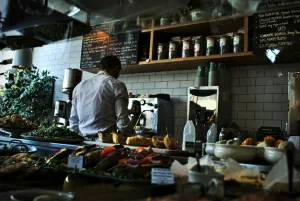Restaurant Rescue Strategies
Table of Contents
The United Kingdom has officially plunged into a recession. Its Gross Domestic Product (GDP) fell 0.3% in the fourth quarter of 2023, following a 0.1% fall in the previous quarter. The fall is primarily due to reduced consumer expenditure and the collapse of retail sales. This slump emphasises the business’s need for financial stability, operational efficiency, and customer focus. To address these difficulties, especially in the restaurant industry, managers and owners must create restaurant rescue strategies to pave the road for the long-term growth and prosperity of their businesses.
Urgent Support Needed as 25% of UK Hospitality Firms Face Cash Crisis
The Plight of UK Hospitality Industry
In the wake of recent economic challenges, the hospitality sector in the United Kingdom is facing a dire cash crisis. Recent surveys indicate that a staggering 25% of hospitality businesses are currently devoid of any cash reserves. This alarming statistic sheds light on the precarious situation engulfing the industry.

Lack of Cash Reserves
The survey conducted across various segments of the hospitality industry has unveiled concerning figures. A significant 29% of establishments admit to having a cash reserve sufficient for a mere three months. Shockingly, a very high percentage of businesses within the sector acknowledge the absence of any cash reserves whatsoever which indicates a real need for restaurant rescue strategies to be in place for the near future.
Industry Appeals for Urgent Support
Various trade groups representing the hospitality sector have issued a collective plea for immediate governmental intervention. Highlighting the pressing need for support, these groups emphasize the gravity of the situation. With businesses teetering on the brink of financial collapse, urgent measures are deemed imperative to avert widespread closures.
Proposed Solutions
Among the proposed solutions, a reduction in Value Added Tax (VAT) emerges as a critical measure to alleviate the financial burden on hospitality establishments. Industry leaders stress the importance of this tax relief as a means to mitigate escalating costs and sustain operations. Additionally, calls for prioritized financial assistance from the Treasury underscore the severity of the crisis gripping the sector.
Joint Industry Statement
In a unified statement issued by prominent industry bodies such as UKHospitality, the British Beer and Pub Association, and the British Institute of Innkeeping, the urgency of the situation is starkly outlined. The collective plea for governmental support echoes throughout the statement, emphasizing the existential threat faced by pubs, restaurants, hotels, and cafes alike.
Businesses in the restaurant and hospitality sectors may face difficulties that jeopardise their sustainability in the fast-paced and cutthroat world of the restaurant industry. Whether due to changing market dynamics, operational inefficiencies, or external factors, rescuing a failing restaurant demands decisive action and strategic planning.
Restaurant Problems and Solutions
Based on industry research, the list of reasons for restaurant failure in order of occurrence from most to least occurrences is as follows. This ranking highlights the critical factors contributing to restaurant failure according to research findings:
Bad Location: A restaurant’s location plays a crucial role in its success. If it’s situated in an area with little foot traffic or lacks visibility, it can significantly impact customer turnout and revenue.
Lack of Experience: Running a restaurant requires a combination of culinary expertise, business acumen, and management skills. Without prior experience or knowledge of the industry, restaurant owners may struggle to navigate challenges effectively.
Hiring the Wrong People: Employees are the backbone of any restaurant. Hiring individuals who lack the necessary skills, commitment, or professionalism can lead to inefficiencies, poor customer experiences, and ultimately, business failure.
Bad Staff Management: Effective staff management involves training, supervision, and fostering a positive work environment. Poor management practices, such as inadequate training, lack of communication, or favouritism, can contribute to low morale and high turnover rates.
Poor Food Quality: The quality of food served is paramount to a restaurant’s success. Consistently serving subpar or unpalatable dishes can drive customers away and tarnish the restaurant’s reputation.
Bad Customer Service: Exceptional customer service is essential for building a loyal customer base and generating positive word-of-mouth. Poor service, including long wait times, rude staff, or inaccurate orders, can drive customers to seek dining experiences elsewhere.
Not Enough Starting Capital: Adequate financial resources are necessary to cover startup costs, operational expenses, and unforeseen emergencies. Insufficient capital can hinder a restaurant’s ability to invest in quality ingredients, marketing efforts, or necessary equipment.
Lack of a Clear Vision: A well-defined vision and mission statement guide the direction of a restaurant and shape its branding, menu offerings, and overall experience. Without a clear vision, restaurants may struggle to differentiate themselves in a competitive market or attract their target audience.
No Marketing: Effective marketing is essential for attracting new customers, retaining existing ones, and increasing brand awareness. Restaurants that neglect marketing efforts may struggle to reach their target demographic or compete with more visible competitors.
Lack of Menu Planning and Proper Pricing: Crafting a menu that balances creativity, profitability, and customer preferences requires careful planning and analysis. Restaurants that fail to regularly update their menus, adjust pricing strategies, or monitor food costs may struggle to remain competitive in the market.
By addressing these common pitfalls and implementing strategic solutions, restaurant owners can increase their chances of long-term success in a competitive industry.

Rescuing A Failing Restaurant
Diagnosing the Underlying Issues
Finding the underlying reasons for a failed restaurant’s downfall is the first step in rescuing it; this calls for a detailed analysis of several factors, such as financial performance, operational inefficiencies, customer feedback, and market trends. By identifying the fundamental problems causing the restaurant industry to decline, operators can create focused plans to deal with these obstacles.
Implementing Operational Improvements
Reviving a failing restaurant requires more than just making cosmetic adjustments. It requires starting a revolution that revitalises the entire eating experience – a restaurant rescue strategy which involves understanding the core of your business, perfecting every little aspect, and producing experiences that have an enduring impact on your visitors. You won’t just be saving costs by optimising workforce numbers, eliminating costs, and streamlining your processes—you’ll also be laying the groundwork for a better future where quality and efficiency are paramount.
Investing in your employees’ growth and development is more than simply a cost; it’s an investment in the heart of your restaurant, ensuring that every interaction is infused with warmth, professionalism, and compassion. As you uncover and address operational inefficiencies, you are doing more than just increasing profits—our commitment to long-term growth and quality will result in many successes. Keep up the excellent work!
Enhancing Financial Stability
Achieving financial stability is critical for a restaurant’s long-term performance and may require renegotiating vendor contracts, improving inventory management, and implementing rigorous cost controls.
Furthermore, looking into alternate revenue streams, such as catering or product sales, can help supplement revenues from dine-in operations. By enhancing financial stability, restaurants can weather economic downturns and position themselves for future expansion.
How To Manage Restaurant Finance, Especially With A Cash-flow Crunch
Revitalizing Menu Offerings and Brand Identity
A restaurant can rekindle consumer interest and draw in new customers by altering its menu items to reflect current culinary trends, sourcing products locally, or presenting inventive specials. It can also revitalise its brand identity.
Rebranding the business through updates to signage or logos can help it take a different position in the market. A failing restaurant can stand out from rivals and draw a devoted clientele by revitalising its food and brand identity.
Re-engaging with the Customer Base
Rebuilding trust and loyalty requires reaching out to former clients and fostering new ones, getting input from them via surveys or comment cards, and putting their recommendations into practice.
Moreover, rewarding loyal members or holding exclusive events can encourage return business and positive word-of-mouth recommendations. By actively engaging with its clientele, a failing restaurant can cultivate a sense of community and loyalty among its consumers.
Related articles:
How To Improve Restaurant Profits
Restaurant Management Structure
Driving Marketing and Promotion Efforts
Creating effective marketing and promotional campaigns is more than just increasing revenue; it’s also about revitalising a failing restaurant, generating excitement, and forging deep connections with our community. It’s about creating a viral buzz, titillating taste sensations, and clearly illustrating what makes us unique. We can reach hearts and minds and craft storylines that resonate strongly with our target audience by utilising the power of digital marketing.
Collaborating with local influencers and participating in community events is more than just a commercial strategy; it’s a sincere effort to develop genuine connections and build a tribe of devoted fans. By putting our passion and creativity into our marketing efforts, we attract new customers and spark curiosity and enthusiasm for our offerings, bringing new life into our beloved restaurant.

Monitoring Progress and Adaptation
Consistently monitoring critical performance metrics and receiving important consumer feedback is at the heart of our efforts to revive and revitalise. It’s more than simply statistics on a spreadsheet; it’s about knowing our company’s pulse and customers’ heartbeat.
By diving deeply into sales data, monitoring customer satisfaction scores, and diligently measuring financial measures, we receive priceless insights about the health of our enterprise.
This path is intensely emotional, with highs, lows, successes, and struggles. Throughout it all, our unrelenting drive to progress and growth propels us forward, directing us to a future of success, satisfaction, and fulfilment.
Conclusion
To summarise, the UK recession poses significant challenges for firms and consumers, needing strategic adaptation and resilience. To successfully weather the economic storm, businesses must have restaurant rescue strategies that prioritise financial stability, operational efficiency, and customer focus.
A carefully considered mix of operational enhancements, menu revitalisation, customer involvement, and marketing initiatives is needed to save a failing restaurant. Restaurant owners may turn around their companies and create the circumstances for long-term success by identifying the underlying problems, putting specific plans into place, and being flexible in the face of shifting market conditions.
Meanwhile, restaurant managers are encouraged to exercise responsible financial management, prioritise necessary expenditures, and seek value for money when purchasing. Government intervention and policy responses are critical to restoring economic stability and sustaining long-term recovery.
Through collaborative efforts and practical initiatives, restaurant owners can alleviate the burdens of recession and pave the road for long-term growth and prosperity. With unified drive and persistent devotion, restaurant managers can overcome adversity’s hurdles and revive more than ever. It’s about pooling resources, and embracing resilience as you face economic instability and move forward with hope, knowing you can overcome any obstacle and create a tomorrow full of promise and opportunity.

